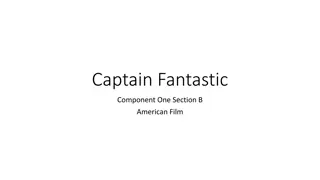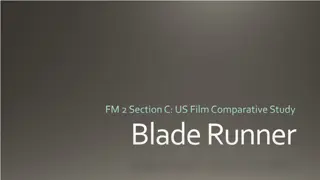Understanding Narrative Theories in Texts and Films
Narrative is the art of storytelling, shaping raw ingredients into a cohesive structure through codes, conventions, and symbols. It explores linear vs. non-linear storytelling, multi-strand and dual narratives, and Barthes' Action/Enigma codes in films. Various techniques are discussed, such as how narratives hook audiences, create expectations, and play with generic conventions to engage viewers.
Download Presentation

Please find below an Image/Link to download the presentation.
The content on the website is provided AS IS for your information and personal use only. It may not be sold, licensed, or shared on other websites without obtaining consent from the author. Download presentation by click this link. If you encounter any issues during the download, it is possible that the publisher has removed the file from their server.
E N D
Presentation Transcript
NARRATIVE Aims: What is the key concept of narrative? How can narrative theories be applied to texts?
DEFINTION Narrative is the art of storytelling Think of the story as the raw ingredients of a text - narrative is the methodology of how it is put together. The narrator or producer of the text cooks it in a certain way. Narrative is also defined by the many codes, conventions, signs, symbols and icons within a text.
La Haine 1995 How does it hook the audience into the film? What expectations are created about the way the story will develop? How much does this depend on our recognition of the genre and its conventions?
Watch the following clip. How does it play with the generic conventions and narrative structure? What effect does this have on the audience?
LINEAR AND NON-LINEAR Non-linear stories are popular in computer games it means the story doesn t follow a straight line. In a game, you can often choose different paths. In films like Memento, the story moves around in time and is often told in flashbacks, where a character looks back in time. https://www.youtube.com/ watch?v=0vS0E9bBSL0 What kind of audience would like this kind of film? Linear narratives are in a straight line from start to end. They attempt to convey a realistic effect NOT realistic aesthetic in terms of timeline They try to suggest a normal timeline of action The follow natural order of how we understand time This is more suited to a mainstream production
MULTI-STRAND AND DUAL NARRATIVES https://www.youtube.co m/watch?v=khB_wpn- bmc https://www.youtube.co m/watch?v=Zmu70sS4C 34 Theses narratives often have more than one story and more than one set of characters. Sometimes the stories cross over and the characters meet. Sometimes, but rarely, they are kept apart These often follow two characters perspective . It is two person story.
BARTHES ACTION/ENIGMA CODES Action codes Enigma Codes Roland Barthes believed that in some films and other narratives one action will lead to another and this is where the story comes from e.g. somebody kills, so a friend hunts them down Here the audience know why things occur. It is a film structure where logic is applied: Action, Adventure and to some extend Sci-Fi & Fantasy apply this code. On the other hand, it can be mysteries that drive a story forward The audience watch to find out why things are happening. This is a more common Narrative code for Genres such as Thriller, Crime, Mystery and even more sophisticated Romance. The audience become engaged with solving or guessing the ending of the story http://www.youtube.com/watch?v=GeeyWvo1rNg http://www.youtube.com/watch?v=t6msq8mgdnE
AN ENIGMA CODE SETS UP PUZZLES WITHIN THE NARRATIVE THAT THE READER, OR AUDIENCE WANTS TO BE SOLVED.
https://www.youtube.com/watch?v=VV1-pePln_I https://www.youtube.com/watch?v=VV1-pePln_I TZVETAN TODOROV https://www.youtube.com/watch?v=VlbcqU0Qgr8 1. The Narrative starts in a state of Equilibrium: Stable, balanced, unchanging system. Todorov suggested that the primary function of the narrative was to solve a problem. Characters pass through a series of stages of a linear narrative where events follow in chronological order. An action or character disrupts the equilibrium. 1. Following recognition of the disruption a quest to restore the equilibrium ensues. 1. Todorov stated that narratives are led by events in a cause and effect format. The narrative moves to a confrontation / climax: there is an attempt to repair the disruption 1. He states that narratives are structured in five logical stages: Resolution / equilibrium is restored and reinstated. 2. This narrative is familiar and is conventional: we see it applied to many mainstream film Narratives 9
TODOROVS NARRATIVE TRANSITIONS Equilibrium Disturbance Complication Climax Resolution Choose a Disney film which you are familiar with, how can Todorov s theory be applied? Why do you think Disney often adopt this narrative structure?
VLADIMIR PROPP Russian literary critic and folklorist, was concerned with the relationship between narrative and characters. He analysed many folktales. Through his research, he argued that stories are character driven and that plots develop around the actions of characters. He looked at characters and their function within the story. He hypothesised that characters have the role of narrative spheres of action or functions and that there were 7 of them although theorists now have extended this list 1. The hero is the agent who restores equilibrium, he carries the events through the story. (In modern narrative, the hero can also be female). He can be a seeker hero or a victim hero 2. The villain who creates the narrative disruption and tries to prevent the hero from accomplishing his mission. Apply this theory to the characters in Star Wars 3. The doner aids the hero by giving him something: an object / advice etc 4. The helper often a sidekick (like figure) who helps the hero / aides the restoration of equilibrium 5. The princess the character most threatened by the villain who has to be saved. Her father rewards the hero (often by giving his daughter as a prize) and is often the despatcher 6. The diepatcher sends the hero on a quest or task 7. The false hero appears to be good and tries to trick the hero by giving bad advice s/he is revealed at the end.
ALLAN CAMERON The Modular Narratives Narrative theory presents the sense of time in moving image productions as divisible and subject to manipulation . Cameron identified four different types of modular narrative: Anachronic modular narratives involve the use of flashbacks and/or flash forwards, with no clear dominance between any of the narrative threads. These narratives also often repeat scenes directly or via a different perspective. Examples include: Pulp Fiction and Memento. Forking-path narratives juxtapose alternative versions of a story, showing the possible outcomes that might result from small changes in a single event or group of events. The forking-path narrative introduces a number of plotlines that usually contradict one another. Examples include Groundhog Day, Sliding Door, Cloverfield and Run Lola Run. Episodic narratives are organised as an abstract series or narrative anthology. Abstract series type of modular narrative is characterized by the operation of a non-narrative formal system which appears to dictate (or at least overlay) the organization of narrative elements such as a sequence of numbers or the alphabet. Anthology consists of a series of shorter tales which are apparently disconnected but share a random similarity, such as all episodes being survivors of a shipwreck. Split screen narratives are different from the other types of modular narrative discussed here, because their modularity is articulated along spatial rather than temporal lines. These films divide the screen into two or more frames, juxtaposing events within the same visual field, in a sustained fashion. Examples include Timecode / Source Code One of the earliest was The Boston Strangler (1968) https://www.youtube.com/watch?v=KH8ZZbzig5Y https://www.youtube.com/watch?v=KH8ZZbzig5Y























